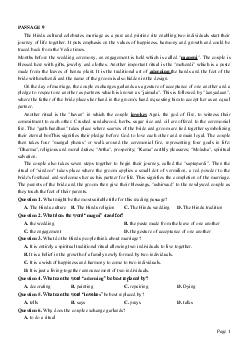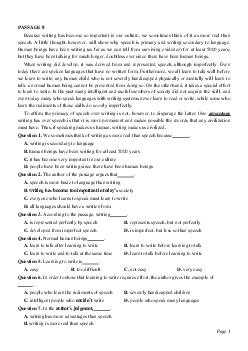


Preview text:
PASSAGE 33
Amphibians are an animal group includes frogs, toads, salamanders and newts. The animals live in and
out of the water. The number of amphibians on our planet is declining rapidly in both local mass
extinctions and population crashes. This is a cause ofr concern as many scientists believe that humans are responsible.
Since the 1980s, scientists have noticed a decline in amphibian populations. Although many animals
are affected by humans, amphibians have been hit particularly hard. Some scientists believe this is
because of their two-stage life cycle. Unlike most animals, amphibians live their lives in two distinct
stages. The first is aquatic and the second is terrestrial. This means amphibians are sensitive to
environmental changes in the water and on land. They also have permeable skin, which means that toxins
and chemicals can easily get into their bodies.
At first, some scientists did not believe that human pollution was the cause for changes in amphibian
populations. These scientists believed that every species on Earth goes through natural cycles and changes
and that there was not enough long-term data to prove that humans were the problem. In recent years, this
has changed. Almost all biologists are concerned about the decline in amphibian populations. They are
worried not only because many amphibians may go extinct, but also because these extinctions will affect
other plants and animals in ecosystems. They believe that the decline in amphibian populations is a
warning to humans to stop polluting and clean up Earth.
Question 1. Which title best summarizes the main idea of the passage? A. Endangered reptiles
B. Endangered amphibians
C. Amphibian life cycle
D. Amphibians and reptiles
Question 2. According to the passage, which of the following is TRUE?
A. The number of amphibians is decreasing rapidly.
B. The number of amphibians is increasing.
C. The number of amphibians is going up.
D. The number of amphibians staying constant.
Question 3. In paragraph 2, the word noticed is closest in meaning to A. studied B. analysed C. become aware of D. started to work on
Question 4. In paragraph 2, the word they refers to A. scientists B. humans C. animals D. amphibians
Question 5. According the passage, which of the following is TRUE about amphibians?
A. First they live on land, then in the water.
B. First they live in the water, then on land.
C. They mainly live in water.
D. They mainly live on land.
Question 6. In paragraph 2, the word toxins is closest in meaning to
A. poisonous substances B. tonic subtances C. essential minerals D. essential vitamins
Question 7. Which of the following can be inferred from the passage?
A. Amphibians contribute greatly to biodiversity.
B. All amphibians will go extinct in the near future.
C. A clean environment may help to protect amphibians from extinction. Page 1
D. Protecting amphibians is the responsibility of all people on Earth. ĐÁP ÁN 1-B 2-A 3-C 4-D 5-B 6-A 7-C
LỜI GIẢI CHI TIẾT Question 1: B
Tiêu đề nào tóm tắt tốt nhất ý chính của đoạn văn?
A. Loài bò sát có nguy cơ tuyệt chủng
B. Loài lưỡng cư có nguy cơ tuyệt chủng C. Vòng đời lưỡng cư
D. Động vật lưỡng cư và bò sát
=> Dẫn chứng: The number of amphibians on our planet is declining rapidly in both local mass
extinctions and population crashes. This is a cause ofr concern as many scientists believe that humans are responsible.
Dịch: Số lượng động vật lưỡng cư trên hành tinh của chúng ta đang suy giảm nhanh chóng trong cả sự
tuyệt chủng hàng loạt tại địa phương và các vụ tai nạn dân số. Đây là một nguyên nhân gây lo ngại vì
nhiều nhà khoa học tin rằng con người có trách nhiệm. Question 2: A
Theo đoạn văn, điều nào sau đây là ĐÚNG?
A. Số lượng lưỡng cư đang giảm nhanh chóng.
B. Số lượng lưỡng cư ngày càng tăng.
C. Số lượng lưỡng cư đang tăng lên.
D. Số lượng lưỡng cư không đổi.
=> Dẫn chứng: The number of amphibians on our planet is declining rapidly in both local mass
extinctions and population crashes
Dịch: Số lượng động vật lưỡng cư trên hành tinh của chúng ta đang suy giảm nhanh chóng trong cả sự
tuyệt chủng hàng loạt tại địa phương và các vụ tai nạn dân số. Question 3: C
Trong đoạn 2, từ “chú ý” có nghĩa gần nhất với A. nghiên cứu B. phân tích C. nhận thức được D. bắt đầu làm việc
=>Since the 1980s, scientists have noticed a decline in amphibian populations
Dịch: từ những năm 1980, các nhà khoa học đã nhận thấy sự suy giảm dân số lưỡng cư Question 4: D
Trong đoạn 2, từ “they” đề cập đến A. nhà khoa học B. con người C. động vật D. lưỡng cư
=> Dẫn chứng: This means amphibians are sensitive to environmental changes in the water and on land.
They also have permeable skin, which means that toxins and chemicals can easily get into their bodies. Page 2
Điều này có nghĩa là động vật lưỡng cư rất nhạy cảm với những thay đổi môi trường trong nước và trên
đất liền. Chúng cũng có làn da thấm, điều đó có nghĩa là độc tố và hóa chất có thể dễ dàng xâm nhập vào cơ thể họ. Question 5: B
Theo đoạn văn, điều nào sau đây là ĐÚNG về động vật lưỡng cư?
A. Đầu tiên chúng sống trên cạn, sau đó ở dưới nước.
B. Đầu tiên chúng sống dưới nước, sau đó trên cạn.
C. Chúng chủ yếu sống trong nước.
D. Họ chủ yếu sống trên đất liền.
=> Dẫn chứng: Unlike most animals, amphibians live their lives in two distinct stages.The first is aquatic and the second is terrestrial
Dịch: Không giống như hầu hết các loài động vật, động vật lưỡng cư sống cuộc sống của chúng trong hai
giai đoạn riêng biệt.. Thứ nhất là thủy sinh và thứ hai là trên cạn Question 6: A
Trong đoạn 2, từ độc tố có nghĩa gần nhất với A. chất độc B. thuốc bổ
C. khoáng chất thiết yếu D. vitamin thiết yếu Question 7: C
Điều nào sau đây có thể được suy ra từ đoạn văn?
A. Động vật lưỡng cư đóng góp rất lớn cho đa dạng sinh học.
B. Tất cả các loài lưỡng cư sẽ tuyệt chủng trong tương lai gần.
C. Một môi trường sạch sẽ có thể giúp bảo vệ động vật lưỡng cư khỏi sự tuyệt chủng.
D. Bảo vệ động vật lưỡng cư là trách nhiệm của tất cả mọi người trên Trái đất.
=> They believe that the decline in amphibian populations is a warning to humans to stop polluting and clean up Earth.
Dịch: Họ tin rằng sự suy giảm dân số lưỡng cư là lời cảnh báo cho con người ngừng gây ô nhiễm và làm sạch Trái đất. Page 3




